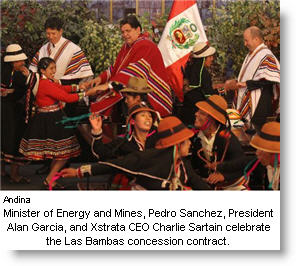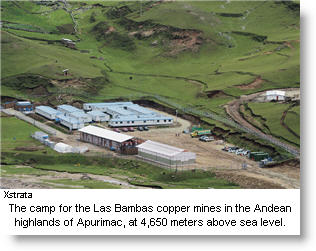In a Government Palace ceremony this week, Peru formally transferred the mining titles of the Las Bambas mineral deposits in southern Peru to the Anglo-Swiss mining group Xstrata. President Garcia qualified the $4.2 billion project as “the contract of the century.”
The $4.2 bn investment in the low-cost, world-class copper mine will be made over 18 years. Xstrata, with headquarters in Zug, Switzerland and operations and projects in 19 countries, acquired the exploration rights to the mineral district in a privatization bid held by Proinversion in 2004.
Las Bambas, located in Apurimac and 75 km from Cusco, is to include three open pit mines –Ferrobamba will be the first, followed by Chalcobamba and Sulfobamba, and later Charcas. Construction is scheduled to begin in the third quarter of 2011, with the first ore to be processed in mid-2014. Ore will be mined at a rate of 51.1 million tonnes per year from the three open pit mines, with an initial production of copper concentrate expected to be 400,000 tonnes per year.
Until now, Antamina has been Peru’s major copper producer, with 360,000 tonnes per year. Xstrata owns a 33.75% interest in Antamina, one of the world’s largest copper-zinc mines, located in the department of Ancash.
 Peru is the world’s second copper exporter, and Las Bambas will increase output by 30%, according to Xstrata.
Peru is the world’s second copper exporter, and Las Bambas will increase output by 30%, according to Xstrata.
According to a company press release, Las Bambas will generate an average of approximately 3,600 direct jobs during construction and 1,350 permanent jobs once in operation. The project is located in one of the poorest regions of the country.
Just two months ago, Xstrata approved an investment of $1.47 bn in Antapaccay, a copper deposit about 10km from Tintaya, the open-pit mine near Cusco that it acquired in 2006 from BHP Billiton.
Antapaccay will expand output at Tintaya by 60 percent to 160,000 tonnes a year and extend the mine life for at least 20 years. The start-up of the new mine will coincide with the end of Tintaya’s mine life in 2012, the company said in a release.
 Las Bambas, some 150 km from Tintaya-Antapaccay, will benefit from the significant synergies of this expansion project, and Xstrata expects to reduce overhead by 15%, with shared management and administrative support functions. Bechtel, Siemens and FLDSmidth are covering construction, systems and equipment for both projects.
Las Bambas, some 150 km from Tintaya-Antapaccay, will benefit from the significant synergies of this expansion project, and Xstrata expects to reduce overhead by 15%, with shared management and administrative support functions. Bechtel, Siemens and FLDSmidth are covering construction, systems and equipment for both projects.
Concentrates from Las Bambas will be pumped through a 215 km pipeline to a molybdenum and filter plant close to Tintaya-Antapaccay and then transported by the same railroad to the port of Matarani. The projects will also share the existing Tintaya road network, a connecting road along the pipeline corridor, an established logistics centre in Arequipa, and the expanded port facilities.
Not everyone was completely happy with the terms of the concession. Carlos Herrera Descalzi, minister of Energy and Mines during the Toledo administration, congratulated the project but recommended that the Government negotiate a higher royalty fee in future contracts – the Las Bambas contract stipulates a payment of 3% royalties and 30% income tax. “It is an issue of equity, in which the wealth should be better distributed between the investor and the State, but this is still not happening,” he said.
Since Xstrata began explorations in the region, it has been careful to build a solid relationship with the local communities, aware of the frequent protests and backlash witnessed at other mines. One of the challenges has been the relocation of the community of Fuerabamba, whose 300 families have accepted the move.
“From our first involvement with the project, we have regarded our relationship with the communities associated with Las Bambas as vitally important and it is very pleasing to confirm that the dialogue we have established between the community and the company has been recognized in the strong public support the project enjoys,” said José Marún, chief executive of operations of Xstrata’s Southern Peru division. The department of Apurimac has 70% illiteracy among local communities, most of which live off subsistence farming.
In its original bid for Las Bambas, Xstrata included a social fund for community development and has contributed $48.5 mn to the fund since 2004. It has also directly invested over $20 mn in social projects in local communities and created an independent Advisory Group to advise the company on sustainable development issues relating to the project. The independent group includes a member from Conservation International.





